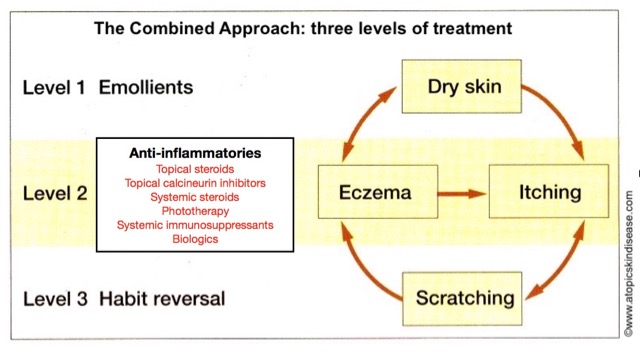Habit reversal and the new eczema treatments

The Combined Approach to atopic eczema is a clinical treatment programme that was developed in the 1980's, first in Uppsala, Sweden and then in London, UK based on the research findings of Dr Peter Norén.
Usually topical steroids are used as the anti-inflammatory treatment in the programme, at Level 2 in the diagram above.
The practitioners manual Atopic Skin Disease [1996] also details how systemic steroids, systemic immunosuppressants and phototherapy are also used at Level 2, often in combination with topical steroids.
Since then a range of new anti-inflammatory treatments have been introduced for eczema.
First, topical calcineurin inhibitors - for example, tacrolimas [Protopic] and pimecrolimus [Elidel], were welcomed as alternatives to topical steroids, especially when local steroid side effects were otherwise problematic. More recently the biological monoclonal antibody - mAb - anti-inflammatory treatment dupilumab has taken centre stage, in a range of possible innovative treatments, usefully summarised in the Lancet in 2020.
In clinical practice however once a habit of scratching is established, removing the itching of inflammation will not always extinguish the habit.
Moreover as the dry skin of atopy and its related itch can remain, so does the central importance of continuing appropriate use of emollients.
Certainly when combined with potent topical steroids and optimal use of emollients, habit reversal can effectively treat chronic atopic eczema when emollients and topical steroids alone are failing to do so.
Clinical experience using The Combined Approach has also shown how habit reversal for habitual scratching also can be successfully combined with the whole range of anti-inflammatory treatments that are now available, providing a means of reducing both the potential side effects of systemic treatments, and perhaps enabling the costs of using the latest treatments to be minimised.
It is argued that chronic and hard-to-treat atopic eczema should, if possible, first be treated with The Combined Approach - optimal topical treatment + habit reversal - before considering more toxic or expensive alternatives.
References
Langar S et al [2020] Atopic dermatitis Lancet 396 345-360
